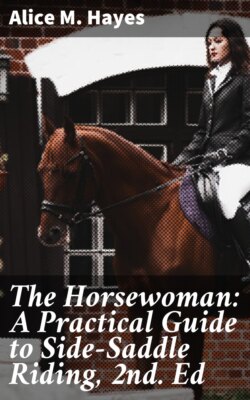Читать книгу The Horsewoman: A Practical Guide to Side-Saddle Riding, 2nd. Ed - Alice M. Hayes - Страница 38
На сайте Литреса книга снята с продажи.
MARTINGALES.
ОглавлениеTable of Contents
The only kinds of martingales which we need consider are the standing martingale which is buckled on to the rings of the snaffle (Fig. 46) and the running martingale (Fig. 47). Following in the footsteps of that high priest of Irish horsemanship, Mr. John Hubert Moore, I pin my faith to the standing martingale, as it has enabled me on many occasions to ride, in peace and quietness, horses which without it would have been most dangerous “handfuls.” Its great virtue, when properly put on, is to prevent the animal getting his head too high. If he be allowed to do this and is unruly, whether from vice or impetuosity, our power over him will more or less vanish, and besides he will not be able to accurately see where he is going, in which case we will be lucky if we escape without an accident. The famous steeplechase horse, Scots Grey, would never win a race without one of these martingales to keep his head in proper position. When lengthened out to its maximum effective length (Fig. 48), it cannot possibly impede the horse in any of his paces or in jumping. It is, of course, well to accustom a horse to its use before riding him in it over a country. It at least doubles one’s power over a puller, and is invaluable for controlling and guiding a “green” animal.
Fig. 48.—Maximum length of Standing Martingale.
It is a common idea that the chief use of a running martingale is to prevent a horse raising his head too high. We find, however, that when our best flat race and steeplechase jockeys and other good horsemen ride with this martingale, they almost invariably have it so long, that it has little or no effect in keeping the head down. When a horse is prevented from raising his head too high by a standing martingale attached to the rings of the snaffle, he is punished by the tension of the martingale being transmitted to the mouth-piece of the snaffle, if he tries to get his head in the air; but the moment he brings his head down and bends his neck, cessation of the painful pressure will reward him for his obedience. This automatic means of dispensing punishment and reward is so accurate in its working, that a horse soon learns the lesson set before him. But with a running martingale, the rider, in order to reward the horse for bringing his head into proper position, would have to slacken out the reins with a promptness that would be seldom attainable, and with an entire disregard of control over the animal. In fact, with a running martingale, adjusted so as to prevent the horse from getting his head too high, the reins would have to perform the dual office of keeping down the head, and of regulating the speed, which duties could seldom be successfully combined. With a standing martingale, however, the rider can safely relinquish the adjustment of the height of the animal’s head to the martingale, and consequently he is not forced to check the horse’s speed, when he wants to get his head down. Some good horsemen, on finding that the running martingale did not perform its supposed office efficiently, have discarded it altogether, and thenceforth have trusted to their hands to act as their martingale. In this they were right not to use a running martingale to keep a horse’s head down; but they were wrong in thinking that keeping the head down was the only, or even the principal, use of this article of gear. If we closely examine its action, we shall find that the great value of this martingale is to aid the rider in turning a horse by keeping his neck straight, when cantering or galloping, which object is greatly facilitated by the opposite rein exerting a strong pressure on the neck.
Fig. 49.—Side view of Horse’s lower jaw.
In regulating the length of the running martingale, we should carefully guard against making it so short that it would interfere with the horse’s mouth, when he is not carrying his head unnaturally high; for such interference could have no good result, and would probably impede the animal’s movements. Although it is impossible to determine with mathematical accuracy the exact length of this martingale, we find in practice that it should not be shorter than a length which will allow it, when drawn up, to reach as high as the top of the withers. Lengthening it out another three or four inches will generally be an improvement. The use of a running martingale shorter than the minimum I have just laid down, more or less irritates the horse; because, even when he holds his head in correct position, he cannot escape from its disagreeable pressure. The employment of a short running martingale for ’cross country work is a very dangerous proceeding; for if the rider does not leave the reins loose when jumping, the horse will be almost certain to hurt his mouth, and consequently he will be afraid to face his bit, or will become unmanageable from pain, either eventuality being highly dangerous to horse and rider.
Fig. 50.—Angle made by the Cheeks of a Curb, when the Reins are taken up.
